The Missoula Art Museum (MAM), in Missoula, Montana, was founded in 1975, and is one of the leading contemporary art museums in the Intermountain West. MAM has one gallery dedicated to Contemporary American Indian Art and recently featured the work of Choctaw artist Marcus Amerman in an exhibit called Indian Country.
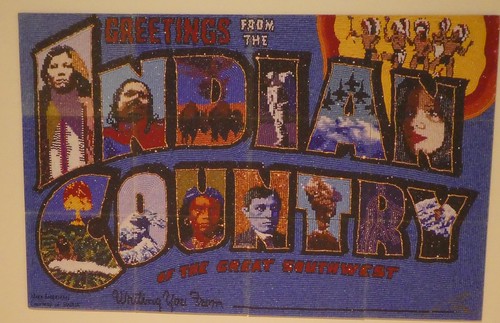
According to the MAM:
“Marcus Amerman is a multi-faceted artist who creates personal expressions across diverse mediums and techniques. He is a painter, beadwork artist, sculptor, and performance artist. Though Amerman may be better known for his beadwork portraits and representational landscapes, this exhibition focuses on contemporary blown glass and mixed media interpretations of traditional objects from his Choctaw heritage.”
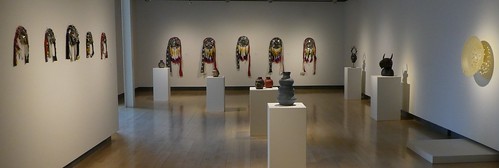
MAM also reports:
“Amerman is widely renowned for his beadwork. He credits the Plateau region and its wealth of talented bead artists with introducing him to the “traditional” art form of beadwork. He quickly made this art form his own, however, by creating a new genre of bead artistry in which beads are stitched down, one by one, to create realistic, pictorial images, not just large color fields or patterns.”

The exhibit includes some interesting glass art pieces. According to MAM:
“Amerman reinterprets vessels and effigies made by the pre-Columbian Choctaw people of the Mississippi River valley. His transformation of the original clay vessels and objects into glass radiates with intensity. The range of style and expressions that glass offers is on display from the sculptural vessels, the large plates with etched-line design, to the purely sculptural, stylized bison heads and figures.”
 Shown above is Florida Feline, made in 2010, blown and sand carved glass.
Shown above is Florida Feline, made in 2010, blown and sand carved glass.
 Another view of Florida Feline
Another view of Florida Feline
 Shown above is Bison head, made in 2010, blown and sand carved glass.
Shown above is Bison head, made in 2010, blown and sand carved glass.
 Another view of Bison head
Another view of Bison head
 Another view of Bison head
Another view of Bison head
 Shown above is Deerman of the Cahokia, made in 2010, blown and sand carved glass.
Shown above is Deerman of the Cahokia, made in 2010, blown and sand carved glass.
The ancient American Indian city of Cahokia, located in present-day Illinois across the river from St. Louis, was founded about 600 CE and reached its greatest development between 1050 and 1250. Conservative estimates say that Cahokia had a population of 10,000, but there are some who feel that its population may have been closer to 75,000. The city of Cahokia included a number of large earthen mounds. The largest of these, today called “Monk’s Mound”, is 1,800 feet long, 710 feet wide, and 100 feet high. It covers 14 acres. The structure which was on top of this mound was 100 feet long and was 50 feet high. The center portion of the city was surrounded by a log stockade.
 Shown above is Sacred Warriors of Snaketown, made in 2010, blown and sand carved glass.
Shown above is Sacred Warriors of Snaketown, made in 2010, blown and sand carved glass.
Snaketown is a Hohokam site in Arizona. Hohokam flourished from 100 BCE until about 1450 CE and was based on irrigated agriculture. The structures and art work at Hohokam show a connection with the civilizations in Mexico.
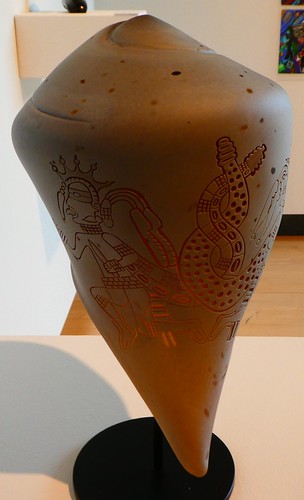 Another view of Sacred Warriors of Snaketown
Another view of Sacred Warriors of Snaketown
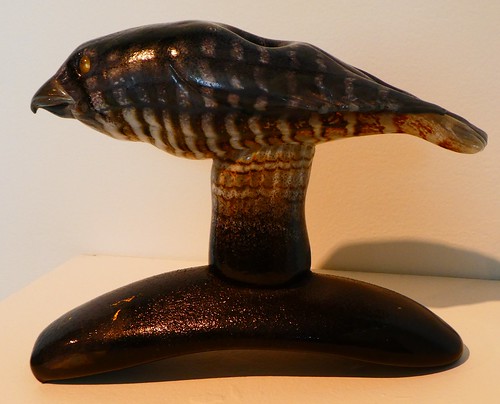 Shown above is Bird Pipe, made in 2010, blown and sand carved glass.
Shown above is Bird Pipe, made in 2010, blown and sand carved glass.
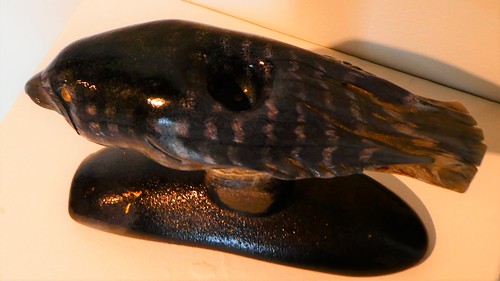 Another view of Bird Pipe
Another view of Bird Pipe
Indians 101
Twice each week, on Tuesday and Thursday, Indians 101 presents American Indian topics. More about American Indian art from this series:
Indians 101: Contemporary American Indian Art of Marcus Amerman (museum tour)
Indians 101: Exploring Glass Art by Native Artists (Art Diary)
Indians 101: Contemporary American Indian Art (museum tour)
Indians 101: Glass Art by Northwest Native Carvers and Weavers (Art Diary)
Indians 101: Reborn Rez Wrecks (museum tour)
Indians 101: Hubcap Shields (museum tour)
Indians 101: Modern Indian Art (Photo Diary)
Indians 101: Nez Perce Indian Art (Photo Diary)


